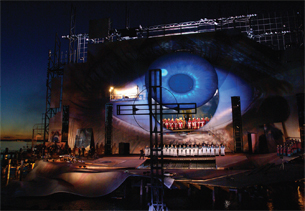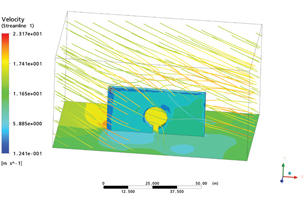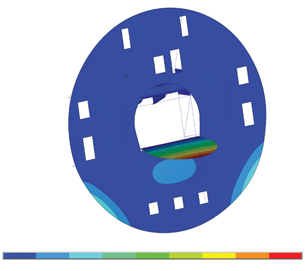Latest News
May 31, 2009
By Russell Shuba
 This stage, which served as a background set in the James Bond film Quantum of Solace, is dominated by an eyeball with a 33-foot-diameter iris. The iris was engineered to rotate and fold out via hydraulics and was simulated using ANSYS. |
If you’ve seen the latest Bond film Quantum of Solace and you were paying attention (you better have to have discovered any kind of story), you’ll recognize the Bregenz Festival’s stunning open-air floating stage. The giant stage, built on the Austrian shore of Lake Konstanz, features a huge eye, 48 meters wide by 31 meters high with an independently moving 10-meter-diameter iris. It was an integral part of the festival’s production of Verdi’s opera Tosca and cost nearly $8 million to build.
What makes the stage even more interesting is that it has already been torn down and replaced by another. The floating stage is completely redone every two years for different productions and has featured everything from a contorted cityscape for West Side Story to a giant open book being looked down upon by an equally giant skeleton for A Masked Ball.
But unlike those previous stages, the one built for Tosca features the iris of a giant eye that can either lift up out of the way to reveal a chorus of bishops or fold down to become a part of the stage on which actors move. Civil engineer Gerhard Lener of Feldkirch, Austria, validated the structural design of the stage to ensure it could safely withstand loads experienced during construction as well as those caused by its moving elements and wind on the eastern edge of a 184-square-mile lake.
Lener used ANSYS finite element analysis (FEA)—with help from CADFEM, an ANSYS channel partner in Germany—to predict the stresses and deformations in the structure at various phases of construction, at various wind speeds, and at different iris positions. He first used linear analysis to check the structure for serviceability then performed nonlinear analysis to ensure it could withstand even higher loads.
“The broad set of analysis capabilities in ANSYS Mechanical software provided the ideal toolset to analyze the Tosca stage because it let us evaluate the structure from every possible standpoint within a single environment,” Lener said.
“These stage sets always represent complex engineering constructions that have to fulfill the artistic and strength requirements simultaneously,” Lener said of the Bregenz floating stage. “Due to the fact that no stage set is similar to a previous one, each becomes a new challenge for the entire team, which has to find solutions in many engineering disciplines.”
 Engineers used finite element analysis to predict the stresses and deformations in the structure at various wind speeds. |
Stage With Structural Challenges
The biggest challenge in the Tosca stage was making sure its structure was strong enough to safely move the iris while staying within the weight limits of the foundation. The moving parts weigh about 250 metric tons, while the entire stage and foundation weigh only 463. During construction, a crane is used that can handle just 12 tons while a small bridge between the stage and the shore is limited to a mere one ton per square meter. This means that any larger components must be moved in small pieces and assembled on the stage itself.
Analysis was further complicated by the fact the eye and its iris are comprised of wood over a steel frame. Connecting the steel and wood together in a shear plane provides additional stiffness beyond the sum of the properties of the two materials.
The stage designer presented Lener with a 100:1 scale model, which was used to create a Pro/ENGINEER solid model to guide the structural design.
“ANSYS Mechanical FEA software was the ideal tool for simulating the floating stage for the Tosca production,” Lener said. “ANSYS provides a very wide range of tools including linear and nonlinear analysis, addressing materials ranging from metal to rubber, a wide range of solvers, and the ANSYS Workbench environment, which provides bidirectional communications with most CAD systems. In my work in performing structural analysis for the last six floating stages for the Bregenz festival, I have encountered a very wide range of structural analysis problems, and ... ANSYS has been able to handle every one.”
Lener worked with ANSYS Mechanical for the main structure because he was able to use a script to generate files that automate the process of analyzing the structure at intermediate positions. Lener modeled the eye’s steel supports with beam elements and its wooden surface using shell elements. Powered by two hydraulic cylinders, the eye rotates 90 degrees between the vertical and the horizontal positions. Lener noted that many structural members receive their highest loading in intermediate positions of rotation, so it was necessary to analyze the structure at multiple positions. Under wind loading, the eye structure deforms as much as 127 millimeters (5 inches).
Analyzing Structural Details
The triangular brackets that connect the eye to the rotating shaft are critical parts of the steel support structure. Lener opened the solid model of this component in the ANSYS Workbench environment.
 By using the nonlinear capabilities of ANSYS, engineers were able to accurately predict the physics involved in simulating the composite wood-steel eye structure. |
“The big advantage of ANSYS Workbench is that it makes it very easy to bring the CAD model into the analysis environment,” Lener said. Based on the analysis results of the triangular support, he changed the wall thicknesses and positions of the stiffeners on the brackets in order to reduce deformations and stresses to safe levels.
Because of the transportation limitations already mentioned, it was critical to model the structure at various stages of construction. For example, the steel structure of the eye is much weaker before the wooden shell is assembled, but, on the other hand, it also experiences less wind pressure. Lener verified that the stage (iris) could perform all movements at normal speed at a wind speed up to 50 kmh (31 mph). There is a range of wind speeds above 50 kmh at which the stage can be moved but at a slower speed. At wind speeds above this level, the iris needs to be moved to a specific position, where it is best able to resist wind loading and held there.
Evaluating the Ultimate Limits
The ultimate limits of the stage structures that take plastic elastic capacity into account were also evaluated with the loads multiplied by safety factors ranging from 1.3 to 1.5. Lener also performed dynamic analysis on various parts of the structure to ensure that it would not resonate and cause vibrations that might interfere with a performance or damage the structure. For example, he calculated the mode shapes and frequencies of the iris to ensure that it would not resonate when several people moved on it at the same time.
When the decision was made to film the James Bond sequence, 1,500 kg (3,306 lbs) of additional lights had to be installed in the upper corner of the eye structure. This required a separate simulation and the structure needed to be strengthened.
“In constructing the floating stages for the Bregenz festival, there is obviously no opportunity for building prototypes or making design changes along the way,” Lener said. “Also, the opening date of the festival is set long in advance, so … the completion date for the stage cannot be changed. The safety of the singers, the stage crew, and the audience depends upon getting the design right the very first time. The use of an FEA tool whose accuracy has been proven on a very wide range of analysis tasks gave the entire project team confidence in the analysis results.”
More Info
ANSYS
Southpointe, PA
CADFEM
Munich, Germany
PTC
Needham, MA
Russell Shuba is a freelance writer who lives outside Madison, WI. When he’s not tracking down a story, he can be found plying the north country’s lakes in a homemade kayak. To comment on this article, send us an e-mail addressed to [email protected].
Subscribe to our FREE magazine, FREE email newsletters or both!
Latest News
About the Author
DE’s editors contribute news and new product announcements to Digital Engineering.
Press releases may be sent to them via [email protected].






